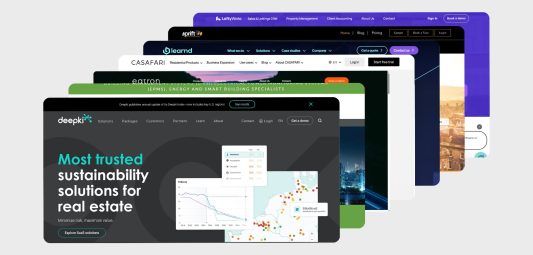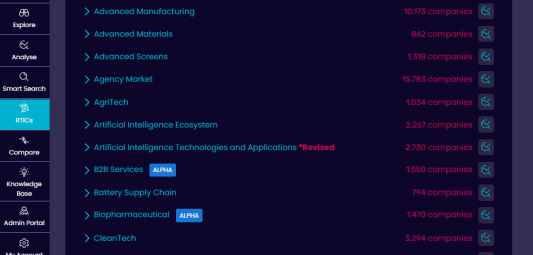As always, we’ve been busy building databases for more of the UK’s most dynamic and exciting sectors. This week we came across a company that defies classic industrial classification.
Our machine learning, and experts in the loop, found it in two separate projects: one looking for AI companies in the UK and the other relating to decarbonising aviation.
It’s an ai-aviation-net-zero mash-up and exactly the kind of company we love finding.
Introducing Satavia
The company is Satavia. They are aiming to prevent 60% of aviation’s climate impact – which equates to 2% of all human-induced climate impact – through AI. They’re a great example of British innovation and have secured funding from Innovate UK, Aerospace Technology Institute and the European Space Agency.
Their DECISIONX platform makes aviation smarter and greener by allowing plane operators, manufacturers and maintenance companies to reduce damage to plane engines and components. It does this by supplying environmental data and analytics. This environmental information can be used to prevent contrail clouds that trap heat in the Earth’s atmosphere. These are created when water vapour from a plane’s engine saturates already moist air, condenses and freezes into ice crystals at high altitude.
“Prior to the COVID-19 pandemic, there were more than 93,000 flights a day across the world. A return flight from London to San Francisco emits around 5.5 tonnes of CO2 equivalent per person – more than twice the emissions produced by a family car in a year. Yet contrail formation exerts a climate impact almost twice as great as plane engine emissions, accounting for around 60% of aviation’s total climate impact.”
Microsoft describe the impact of contrail clouds in their case study on Satavia.
Airline operators can use the information provided through the platform to change flight plans. This allows them to increase engine lifetimes, improve engine performance and reduce both carbon emissions and maintenance costs.
They’re clearly a company playing an important role. Satavia is creating jobs, developing intellectual property and is involved in the vital effort to achieve net-zero carbon emissions.
So why are they so hard to find in the official data?
AI is the future of industrial classification, as well as aviation
Like many innovative companies, Satavia’s founder Adam Durant couldn’t find a satisfactory SIC Code when he registered in 2013. He chose SIC Code 62020 – Information technology consultancy activities. It describes some of what the company does, but is far from a perfect description.
The idea of a technology company using AI to reduce greenhouse gas emissions is all a little too much for our friend the SIC Code. It just can’t cope with the concept. Is Satavia an aerospace manufacturer (30300 – Manufacture of air and spacecraft and related machinery)? Is it an environmental consultant (74901: Environmental consulting activities)?
Of course, Satavia isn’t quite any of those things. Earlier we described them as an ai-aviation-net-zero mash-up. Of course, there isn’t a SIC Code for this, it’s new. It’s innovative. And it cuts across many categories. It defies classic industrial classification.
That’s the problem with a static industrial classification systems. They can’t keep up with innovation and they make it hard to find progressive companies like Satavia in the official data.
So how would you find other companies that defy categorisation?
Our AI spotted Satavia’s platform, DECISIONX, when it was sifting through 1.1m UK websites to find artificial intelligence companies in the UK. And it was their decarbonising impact that it spotted when building a list of companies involved in the UK net-zero supply chain.
We’ve built one of the UK’s most complete company databases. Our technology mines data from over 830,000 company websites and relates it to other records from Companies House and CreditSafe. This method supplies access to 400GB of data on UK companies from which to map any sector.
There are a number of ways to build a sector using our platform. Often, we start by creating a training set of 20-30 good examples of the companies we want to find. However, in instances where we have very niche sectors to explore, we take a different approach.
This approach uses keywords used by companies on their websites to build a training set. For Satavia this would be keywords like ‘aviation’, ‘net-zero’, ‘artificial intelligence’ and so on. We work with specialists in the sector to create these keyword sets (which we call classifier terms).
Classifier terms and the expert in the loop
The classifier terms help train our AI to find the kind of companies we’re looking for in our 400GB of data. The classifier terms are assigned numerical values, positive and negative, depending on their value to the sector. Thanks to these values, the algorithm evaluates whether a company is to be included or excluded from the list.
We let the AI do its thing and then go back into the platform, with our sector expert, and train the AI with negative examples once the first database has been created. For example, when looking for companies like Satavia based on those keywords the algorithm might return Boeing’s website. Though relevant, it’s not what we’re looking for so we would tell the algorithm to ignore companies like Boeing.
At this stage we often update the classifier terms by adding another keyword more specific to the companies we’re looking for, like ‘contrail formation’. We might also add other keywords to filter other companies out.
This process of database building and modification continues until we’re happy we’ve captured the right companies.
A new way of exploring the emerging economy
This process allows us to find and define new sectors (like AI-aviation-net-zero mash-up). It tests the accepted categorisation of companies and allows us to share exciting examples of innovation.
So that brings us to an obvious question. How many AI-aviation-net-zero mash-up companies are there in the UK? Well. I’m afraid that’s a topic for a different day but its exactly the kind of question we love answering at The Data City.


